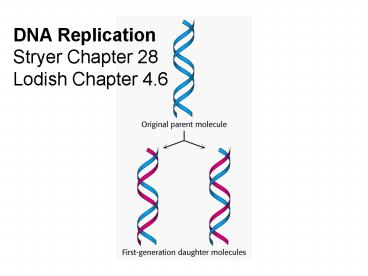DNA Replication PowerPoint PPT Presentation
1 / 24
Title: DNA Replication
1
DNA Replication Stryer Chapter 28 Lodish Chapter
4.6
2
Meselson/Stahl density transfer experiment in 1957
3
(No Transcript)
4
There are various problems that must be
overcome for DNA polymerase to copy DNA
- DNA polymerases are unable to melt duplex DNA in
order to separate the two strands that are to be
copied - All known DNA polymerases can only elongate a
preexisting DNA or RNA strand (the primer) and
are unable to initiate chains - The two strands in the DNA duplex are opposite in
chemical polarity, but all DNA polymerases
catalyze nucleotide addition at the 3?-hydroxyl
end of a growing chain, so strands can grow only
in the 5? to 3? direction
5
(No Transcript)
6
(No Transcript)
7
Humans generate more than 30,000,000 (!)
Okazaki fragments that need to be joined by DNA
ligase I
8
(Barnes et al.)
- Patient had severe growth retardation and
immunosuppression (selective IgA deficiency) - Recurring infections, patient died of pneumonia
at age 19 - Hypersensitive to sun light
- Suffered from lymphoma
- Overlapping symptoms with Bloom Syndrome and
Ataxia Telangiectasia, but the three diseases are
genetically distinct
(Webster et al., Lancet, 1992)
9
(No Transcript)
10
The lagging strand loop
Size of Okazaki fragments 1 kb in
prokaryotes 150 bp in eukaryotes (appr. the size
of a nucleosome) Fork progression rate 100
kb/min in prokaryotes 0.5-5 kb/min in eukaryotes
11
DNA polymerase III has 5 to 3 Processivity (Korn
berg discovered DNA pol I in 1954, Nobel Prize in
1959)
12
Schematic model of the proofreading function of
DNA polymerase
13
Mammalian DNA polymerases
14
Lack of proofreading activity in pol? causes
epithelial cancer, but loss of proofreading
activity in the mitochondrial pol? causes
pre-mature aging (all done in mouse models)
15
The processivity of DNA polymerase is increased
by a ?-subunit dimer clamp
16
Proliferating cell nuclear antigen
17
Replication protein A
Pol?
The eukaryotic replication fork
Replication factor C
18
OriC in E.coli
19
DnaA protein initiates replication in E. coli
20
The initiator ORC binds to the ACS in yeast ORI1
ORC
ORI1
The origin recognition complex has 6 subunits
and binds DNA in an ATP-dependent manner. ORC
recruits other factors to initiate DNA
replication.
21
Replication at each origin is initiated by a
pre-replication complex
ORC-DnaA Cdc6-DnaC MCM-DnaB
Pre-replication Complex (pre-RC)
MCM-minichromosome maintenance complex Cdc-cell
division cycle
22
Telomeres have single-stranded, repetitive
overhangs that form t-loops
In humans, telomere loops can be up to 15kb in
length
Repeat sequence GGGTTA in humans
GGGTTG in the ciliate
Tetrahymena G1-3A
in yeast
23
Lagging strand
3
5
ORI
Telomerase, a reverse transcriptase solves the
end replication problem
3
5
Leading strand
ORI
ORI
24
What you need to know Polymerization only in 5
to 3 direction DNA polymerases have proofreading
activity (except for DNA poly- merase
alpha/primase complex in eukaryotes) Nascent DNA
initiated by RNA primer Leading/ lagging strand
(continuous and discontinuous synthesis
makes Replication semi-discontinuous) Beta
clamp/PCNA (processivity factor) DnaA
(initiator), DnaB (helicase), DnaC (helicase
loader) ORC (initiator), MCM (helicase), Cdc6
(part of helicase loader) DNA ligase/DNA ligase I
(seals Okazaki fragments) Telomerase (why, how)
to prevent telomere shortening reverse
transcriptase activity, carries its own template
RNA Sequence in telomeres is therefore repetitive
in nature

